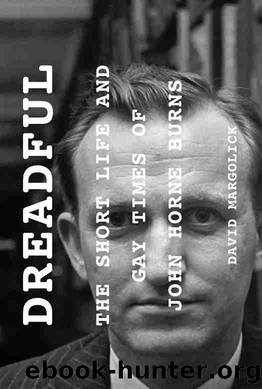Dreadful by David Margolick

Author:David Margolick [Margolick, David]
Format: epub
ISBN: 978-1-59051-572-3
Published: 2016-10-23T00:00:00+00:00
* * *
* The 1939 anti-lynching song popularized by Billie Holiday.
â Though itâs startling to see the word âgayâ appear (twice) in something written in 1947, it had already been in use for a decade or more. And with thousands of gay soldiers circulating it during the war it became, as Sagarin put it, âa magic byword in practically every corner of the United States where homosexuals might gather.â
18
Great war novels inevitably follow great wars, and in literary circles everyone was wondering what would succeed A Farewell to Arms and All Quiet on the Western Frontâand who would write it. But perhaps because of its unusual format, perhaps because it lacked blood and guts, perhaps because the war was barely over and the author completely unknown, The Gallery proved a hard sell.
In early May 1946 Burns sent the manuscriptâ507 pages in a pair of bound books, wrapped lovingly in brown paper that made it look like two pounds of smuggled butter, insured to the hiltâto Robert Linscott, an editor at Random House. Three weeks later, Burns complained to MacMackin that it remained stuck on Linscottâs desk. In fact, it had already been cleared away. The sketches âare rather well done but (I would say) completely unsaleable at the present time,â Linscott wrote, without elaborating, in his internal evaluation. The editors were more polite, telling Burns it would work only as a traditional novel, which to Burns was not an option. They also asked to see his next book, tentatively titled Chain Reaction, though it would not be done for another year. âAt present Iâm quite writ out in the best Vermont Yankee sense and quite depressed,â he told Beulah Hagen. The Log reported, on Burnsâs say-so, that Random House rejected the book because it was ânot entirely pro-American.â It would have to be shopped around.
In late May, Burns was finally ready to face New York. Or, as he told Hagen, âafter four months I decided that I was sufficiently calmed down to venture a visit, with none of the Tintern Abbey overtones of five years afterward.â* With surprising tentativenessâas if realizing heâd made of their relationship something it had never been or could ever beâhe broached reuniting with Beulah Hagen. (With equally revealing unease, heâd asked MacMackin if he could crash on his couch. It was as if they were the only two people he knew.) Back came a telegram from Beulah, inviting him to dinner. So, on the first of June, 1946, carrying a bouquet of tulips and ferns through a downpour, Burns made his way to 38 Sutton Place South, and to âFrau Moe.â âWhen she opened the door to 4-A my emotion was so overpowering that all I could do was thrust the flahrs at her, burbling something,â he wrote Holger Hagen, whoâd yet to return home. Even at Frau Moeâs, war had brought its dislocations: the Bechstein was now on the other side of the room. Before long, the tulips were in a blue pot and a martini in Burnsâs hand.
Download
This site does not store any files on its server. We only index and link to content provided by other sites. Please contact the content providers to delete copyright contents if any and email us, we'll remove relevant links or contents immediately.
| Biographies & Memoirs | Comics & Graphic Novels |
| LGBT Studies | Literature & Fiction |
| Mystery & Thrillers | Romance |
| Science Fiction & Fantasy | Travel |
Spoiler Alert: The Hero Dies by Ausiello Michael(2441)
Insomniac City by Bill Hayes(2087)
Bossypants by Tina Fey(1998)
No Ashes in the Fire by Darnell L Moore(1984)
The Book of Joan by Lidia Yuknavitch(1631)
Boy Erased by Garrard Conley(1412)
Lucky Jim by Kingsley Amis(1370)
Journey to the Abyss by Harry Kessler(1344)
Tranny by Laura Jane Grace(1333)
In the Dream House by Carmen Maria Machado(1333)
Redefining Realness by Janet Mock(1217)
Difficult Women by Roxane Gay(1196)
Love Wins by Debbie Cenziper(1147)
You Can't Touch My Hair by Phoebe Robinson(1146)
Invisible Women by Caroline Criado Perez;(1140)
Tell by Major Margaret Witt(1103)
In the Darkroom by Susan Faludi(1094)
Girlish by Lara Lillibridge(1070)
Course Correction by Ginny Gilder(1050)
